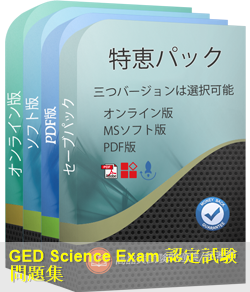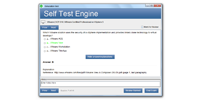ダウンロード可能なインタラクティブGED-Scienceテストエンジン
GED Certificationの基礎準備資料問題集には、GED Certification GED-Science試験を受けるために必要なすべての材料が含まれています。詳細は、正確で論理的なものを作成するために業界の経験を常に使用しているGED Certification によって研究と構成されています。
GED-Scienceの迅速なアップデート対応
GED-Science試験に変更がございました場合は、現在の試験と一致するよう、瞬時に学習資料を更新することができます。弊社は、お客様に最高、最新のGED GED-Science問題集を提供することに専念しています。なお、ご購入いただいた製品は365日間無料でアップデートされます。
あなたのGED-Science試験合格を100%保証
JPNTestテスト問題集を初めて使用したときにGED Certification GED-Science試験(GED Science Exam)に合格されなかった場合は、購入料金を全額ご返金いたします。
GED-Science試験の品質と価値
JPNTestのGED Certification GED-Science模擬試験問題集は、認定された対象分野の専門家と公開された作成者のみを使用して、最高の技術精度標準に沿って作成されています。
JPNTestでGED GED-Science問題集をチョイスする理由
JPNTestは、1週間で完璧に認定試験を準備することができる、忙しい受験者に最適な問題集を提供しております。 GED-Scienceの問題集は、GEDの専門家チームがベンダーの推奨する授業要綱を深く分析して作成されました。弊社のGED-Science学習材料を一回のみ使用するだけで、GED認証試験に合格することができます。
GED-ScienceはGEDの重要な認証であり、あなたの専門スキルを試す認定でもあります。受験者は、試験を通じて自分の能力を証明したいと考えています。 JPNTest GED Science Exam は、GED Certificationの300の問題と回答を収集して作成しました。GED Science Examの知識ポイントをカバーし、候補者の能力を強化するように設計されています。 JPNTest GED-Science受験問題集を使用すると、GED Science Examに簡単に合格し、GED認定を取得して、GEDとしてのキャリアをさらに歩むことができます。
GED Science 認定 GED-Science 試験問題:
1. The widespread use of antibiotics has created a frightening threat to our safety. While antibiotics have offered life-saving treatment for countless diseases, their misuse and overuse have contributed to the evolution of deadly bacteria that are resistant to treatment. Although there is a reluctance to give up the demand for antibiotics, most people accept scientists' warnings of impending catastrophe.
Which choice best explains why doctors now prescribe antibiotics less often than in the past?
A) Bacteria become resistant to treatment by certain antibiotics.
B) Time constraints prevent doctors from writing as many prescriptions.
C) Antibiotic use causes frequent digestive upsets.
D) Insurance does not cover many antibiotic prescriptions.
E) The newer antibiotics are too expensive for the average consumer.
2. Exhibit: Profiles (side views) can be used to tell the geologic changes in mountain ranges.
Which characteristic of the three profiles shown at the left is most useful in arranging them according to age?
A) the number of streams in the mountains
B) the height of the peaks
C) the number of valleys in the mountains
D) the mineral content of the rock in the mountains
E) the width of the base of the mountains
3. Warren is a small town built on the edge of a river. Upstream from Warren, there is a factory on one side of the river and a large farm on the other side. Recently, a resident of Warren discovered a large number of dead fish on the bank of the river, as shown below.
The residents of Warren want to know why so many fish died in that location.
Which would be the most realistic first step to take in determining the cause of the fish kill?
A) Divert the river so that it no longer flows past Warren.
B) Evacuate the town of all its residents.
C) Close the factory, the farm, and all of the other businesses in the town.
D) Perform tests on the river water to determine the types and amounts of pollutants in the water.
E) Measure the distance between the fish kill, the town of Warren, the farm, and the factory.
4. The results of a study of an experimental drug treatment seem to suggest that it is quite effective in treating an eye disease. The table below indicates the results of the use of the
experimental drug therapy on 500 males who are 40-60 years old.
Based on the information and table, which statement is the best conclusion?
A) The experimental drug therapy shows promise, but it needs to be tested much more fully.
B) The strong recovery rate of human subjects treated with established drug therapy makes the experimental drug therapy unnecessary.
C) The experimental drug therapy can now be used with any patient who has this disease.
D) Similar results would have been obtained from a study of females in the same age group.
E) Most of the human subjects in the study would have had a natural reversal of the symptoms even if they were not treated.
5. During an electrical storm, a lightning flash is seen before the sound of thunder that it generated can be heard. The farther a person is from the storm, the greater the time interval between the light flash and the arrival of the sound. Which of the following statements best explains this phenomenon?
A) Electricity can travel rapidly in the Earth's atmosphere.
B) Light travels faster than sound.
C) Lightning consists of a flash of light followed by a loud sound.
D) Sound travels somewhat faster than light.
E) The density of the atmosphere decreases the speed of light.
質問と回答:
| 質問 # 1 正解: A | 質問 # 2 正解: B | 質問 # 3 正解: D | 質問 # 4 正解: A | 質問 # 5 正解: B |


 310 お客様のコメント
310 お客様のコメント





